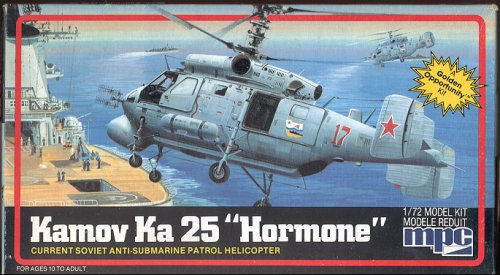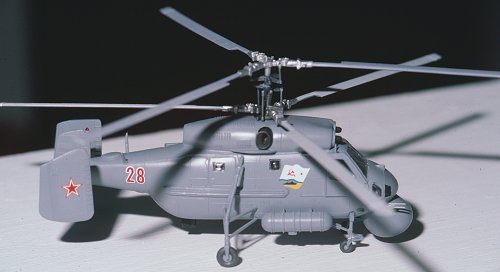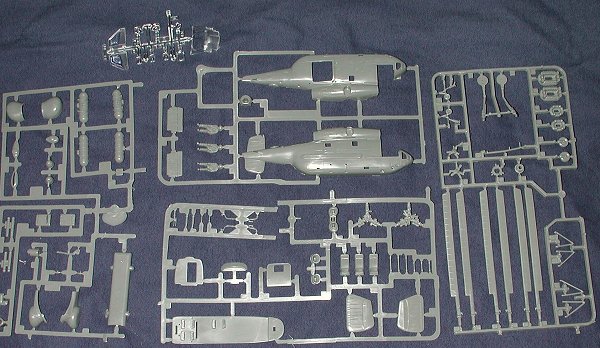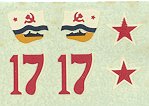
|
KIT: |
MPC/Airfix 1/72 Ka-25 'Hormone' |
|
KIT # |
4214 |
|
PRICE: |
$ long out of production |
|
DECALS: |
One option |
|
REVIEWER: |
Scott Van Aken |
|
NOTES: |

|
HISTORY |

Straight from the box using Microscale decals
The Ka-25 'Hormone' was designed primarily for shipboard ASW and Recon purposes. It's counter-rotating rotors allows for a smaller 'footprint' and also eliminates the need for a tail-rotor as the torque of the two blades cancel each other out. Several US helicopters have used similar 'dual main rotor' set ups such as the Sikorsky H-21 where they are at opposite ends of the airframe and the Kaman H-43 where they are next to each other and intermesh. All of these tail-rotor-less designs need to have a rather large empennage to help maintain stability in forward flight.
The smaller footprint is perfect for shipboard use, or other applications were space is a premium, such as oil rigs. However, the downside to this configuration is that the rotor/shaft configuration is extremely complex, requiring special care and maintenance.
Capacity and lift are limited due to the small size so one would classify this helicopter as a light lift variant, capable of handling only a minimal amount of equipment. There are various sonar and radar equipment installed on the Hormone, making it a rather useful and effective ASW platform. Although the Ka-25 has been replaced by the Ka-27 Helix in Russian service, the Hormone can still be found, mostly with smaller navies that cannot afford the newest equipment.
|
THE KIT |

Back in the early 1980s, MPC imported nearly the entire Airfix line, repackaging the kits in MPC boxes and putting in their own decals and instructions. In all respects, the plastic is exactly the same as what comes in Airfix boxes. The Hormone is one of the better Airfix kits. No rivets or moving control surfaces for this one. Panel lines are very nicely done and of the raised variety. A full cockpit and something of a cabin are provided. To most helo kit makers surprise, they will find both the cyclic and collective in this one, though no rudder pedals. There are three generic seats with three equally generic crew members. The instrument panel has some raised detail, but it isn't very accurate! Clear pieces seem to have the required sink areas in the middle of the smaller pieces, something that almost seems an Airfix trait!
The cabin door can be posed open if one desires, but there is little to see in there. The kit makes several variants so there are optional bits provided. One is the option to put floatation gear around the wheels. Another is to open the back of the fuselage for insertion of some sort of ASW device. There are also hoists, two different nose radar pods, a flat underside panel and a tail radome as well as other bits and pieces that can be scabbed on the side in terms of weapons pods or lights.
 Instructions are very
good, providing clear construction steps and different areas for doing
the A, B or C variant, though there is no explanation of what all the
different versions are in terms of mission. It seems as if the A version
is what is the primary kit is supposed to be, though not all the antennas
shown on the box art are included in the kit. There is a single small
decal sheet for Red 17. I seriously doubt if all three versions were Red
17, so the modeler really needs to do some research into the aircraft
before deciding on a variant and markings. The instructions would have
you do the kit in an overall grey, which is not only easy to paint, but
does make for a fetching model.
Instructions are very
good, providing clear construction steps and different areas for doing
the A, B or C variant, though there is no explanation of what all the
different versions are in terms of mission. It seems as if the A version
is what is the primary kit is supposed to be, though not all the antennas
shown on the box art are included in the kit. There is a single small
decal sheet for Red 17. I seriously doubt if all three versions were Red
17, so the modeler really needs to do some research into the aircraft
before deciding on a variant and markings. The instructions would have
you do the kit in an overall grey, which is not only easy to paint, but
does make for a fetching model.
|
CONCLUSIONS |
I've built this kit not once, but twice, the first build taking 'Best Soviet Aircraft' at a contest in 1985. It is a very nice kit and what's more, takes up a lot less space than your average helo. Though not currently in the catalogue (March 2004), it is not difficult to find at swap meets and generally for around $5 or so.
If you would like your product reviewed fairly and fairly quickly by a site that has nearly 250,000 visitors a month, please contact me or see other details in the Note to Contributors.